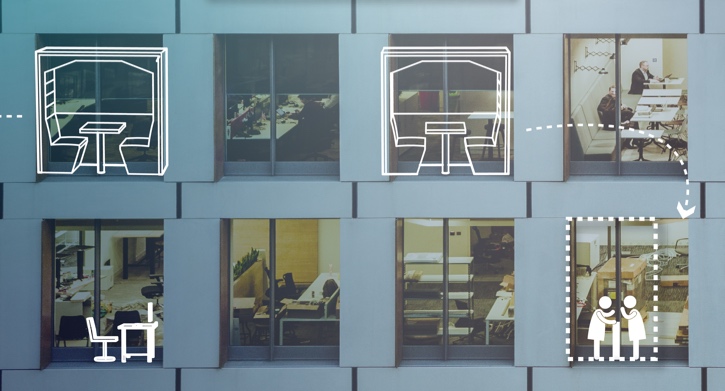Event
Recap
Workplace Transformation 201: Building a Socially Responsive Workplace
By Bennett Kirschner - 19th May, 2023

To Find the Solution You Never Knew Existed, Keep an Open Mind
On April 27th, PLASTARC hosted its “Workplace Transformation 201: Building a Socially Responsive Workplace” webinar. Over the course of an hour, three panelists reflected on the impetus for change brought by the pandemic and how this opened up countless organizations to a re-framing of what their office should prioritize. The initial sense of urgency devoted to reopening offices safely eventually gave way to a prevailing sense of opportunity, as many organizations embraced a need to design for community and longer-term versatility. This discussion expanded on PLASTARC’s previous webinar by touching on the ways in which people-centered metrics are transforming our perception of the office, from cost center to enabler of performance and culture, and how dynamic feedback systems can be used to continually and impactfully update the workplace.
The panel was led by PLASTARC’s socialspatial designer, Amy Rosen, and featured a range of voices: Andre Soluri, the Founder and Principal of Soluri Architecture, a progressive design-oriented firm based in New York; Ann Kalayil, the Associate Vice President of Facilities and Construction at Columbia College Chicago; and Sandra Panara, who serves as Director of Analytics, Insights, & Innovation at Relogix. Together, they explored how a company’s underlying workplace philosophy and openness to change will ultimately determine its preparedness for an unpredictable future.
Towards the start of the conversation, Panara made a vital distinction between utilization and occupancy, two statistics that are sometimes used interchangeably but point to very different phenomena. While we’re collectively fixated on the 50% occupancy statistic that most offices seem to be hovering around, the overall utilization of space – in other words, the amount of time a space is actually used – is closer to 30%. Panara emphasized that this distinction is especially critical for companies seeking the best path forward, as they contend with long-term leases they signed before their workforce hybridized. To understand how a space is (or isn’t) being used, companies must create discrete data sets that demonstrate exactly how workers are interacting with a space. Once that understanding is reached, organizations in this position can confidently implement any number of solutions, including subleasing excess space, donating it to a local non-profit, repurposing it for coworking, “hibernating” it until it's needed again, or abandoning it altogether.
This resonated particularly with Kalayil, who was originally tasked with overseeing the development of Columbia College’s 10-year campus master plan in fall of 2019. With the onset of COVID-19 forcing the school to pivot away from its traditionally in-person pedagogy and towards a remote model, much of Kalayil’s initial research had to be scrapped and redone. But unexpectedly, she noted, the pandemic also provided an opportunity for “stronger interdepartmental and external partnerships that had not previously existed, [and] we were able to leverage…those new [relationships] to…streamline campus planning processes.” Thanks to this unimpeded exchange of ideas, Kalayil’s team quickly recognized a shared need to consolidate the school’s footprint, along with a demand for spaces that students could use to transition quickly from virtual learning environments to traditional, in-person classrooms. Having identified a number of underutilized spaces, Columbia College was able to vacate several floors and repurpose some of them for the emergent learning environments that have served students and faculty alike.
Soluri, who has helped design spaces of varying sizes, from large corporate headquarters to five-person offices, believes that these kinds of transformations are essential in order for an organization to serve its workforce’s evolving needs. And while money is certainly a factor in these considerations, he noted, “a lot of it is ultimately about mindset.” Before anything else, organizations need to be able to relinquish their preconceived notions so that they can respond to what’s actually going on. While serving as a member of AIANY’s Unified Task Force during the height of the pandemic, Soluri helped restaurants practice open-mindedness as they designed structures for outdoor dining. “When you start to look at the aspects of outdoor design that [we consider] simple, [you realize] there are hundreds of decisions that…make them effective or ineffective.” And by accepting that the future held any number of potential outcomes, restaurants were able to create spaces that directly responded to the immediate circumstance but could also be used for other future purposes, such as retail, community events, or presentations.
Though each of the panelists technically works in a different field, they all recognized a great deal of alignment in the questions and problems they’re facing. Kalayil, whose position largely revolves around the use of sensors to extract utilization data, was fascinated by Soluri’s idea of open-mindedness. “When you don’t have a specific goal in mind, and you’re just curious about what’s actually happening, it creates more of an opportunity to learn the reality of your space without [the bias of] an agenda,” she remarked. Kalayil went on to explain how sensors only need to be deployed in a workplace for 30 days to provide a complex array of data, from usage of desks, to multisensory factors such as sunlight exposure and temperature. Equipped with this data, a truly curious organization can uncover and identify the most efficient and sustainable solution.
By striving to identify and meet the workforce’s needs, while encouraging continued creativity and exploration – just as a university should do for its students! – organizations can foster a truly productive and inclusive workplace. But companies also need to know how to discern more contextual changes, which may only last a few months, from those shifts that will stick around for years or even decades to come. Join us as we explore this topic in our next webinar, “Sudden Shifts & Long-Term Solutions: Looking Back on 3 Years of Workplace Change,” on Thursday, June 1.

